“我刺穿画布并非为了摧毁图像。正相反,我制造孔洞是为了寻找别的东西”。他说。
他一点点地刺穿了一张纸,所形成的孔洞从中心向外螺旋展开,孔洞组成的形状没有规则。刺穿纸面、产生孔洞的同时,孔洞边沿的纸会翘起、突出于纸张表面。从侧面打光,图像就因此产生了阴影,变得立体。他是封塔纳。
2019年,在他诞辰120周年之际,一个规模庞大的封塔纳回顾展相继在纽约大都会艺术博物馆、毕尔巴鄂古根海姆博物馆、巴黎现代艺术博物馆等举办。展览名为:“新纪元”。
卢西奥·封塔纳:新纪元Lucio Fontana: on the Threshold
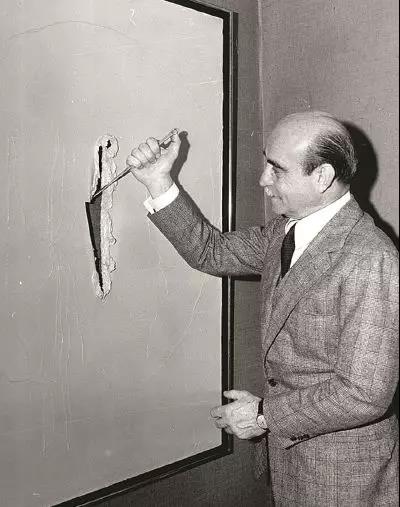
一刀成名!
凭借“几刀”或者“几个洞”,他在离世后的几十年里,创造了一次又一次的拍卖神话。但他的成就何止这“一刀”或者“几个洞”。
“对月球上空间氛围的诗意遐想。你进入了一个洞穴,紫色光束照射在悬停于空中的物体和重型之物上,它们形似史前生物。这件看似鬼魅的作品,让你感到如坠海底。我们就同被一块巨型陶瓷包裹着,而陶瓷内部被紫外光照亮。四周没有边界,一切都让人如漫步于无意识的边界,在此,空间没有中心,不存在任何物体的表面。”1949年2月,封塔纳在米兰纳维利奥美术馆安装了第一件“空间环境”装置作品——《黑光下的空间环境》。批评家奎多·巴洛观看这件作品时,生发出这样的感慨。
2019年,观众们同样可以通过这样的一个空间去体会艺术家当时的心境。
只是这次,是红色的。来,在视频里,穿过红色的墙,走进他曾经无数次探索的红色霓虹灯氛围下的迷幻空间里,感受他的激情时刻:
名为“新纪元”的回顾展是40多年来卢西奥·封塔纳(Lucio Fontana)在美国的首次回顾展,通过选择1931年至1968年间的雕塑、陶瓷、绘画、素描和空间环境作品,重新评估这位战后重要人物的艺术影响。这次回顾展还探讨了封塔纳作为一名雕塑家的开端,以及他在环境方面的开创性工作,在他更广泛的实践中,将这些切割的激进本质融入其中。
三个展厅,其中两个在位于3楼和5楼的大都会布劳耶博物馆(Met Breuer),另一个在大都会第五大道913号画廊(gallery 913)。
是的,除了刺穿画布的那“一刀”,他还是空间和光环境的先行探索者;此外,在雕塑和陶瓷艺术方面也很有建树。
展览现场:
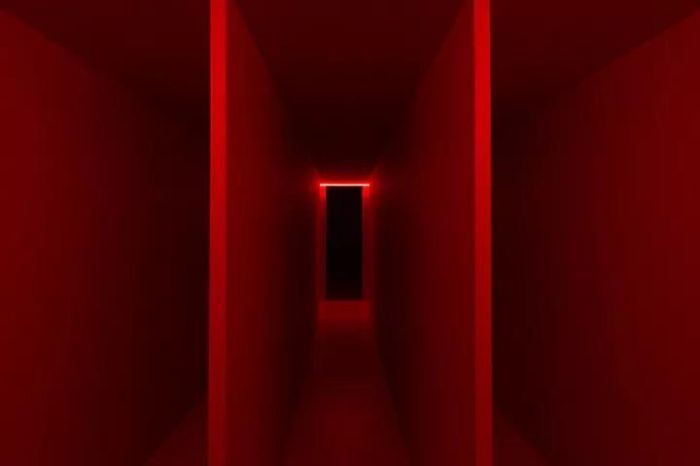
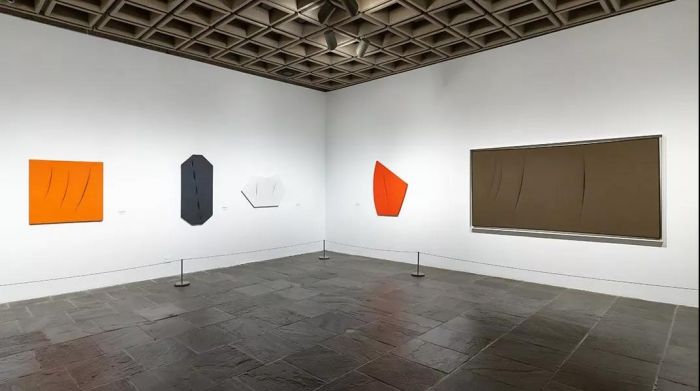

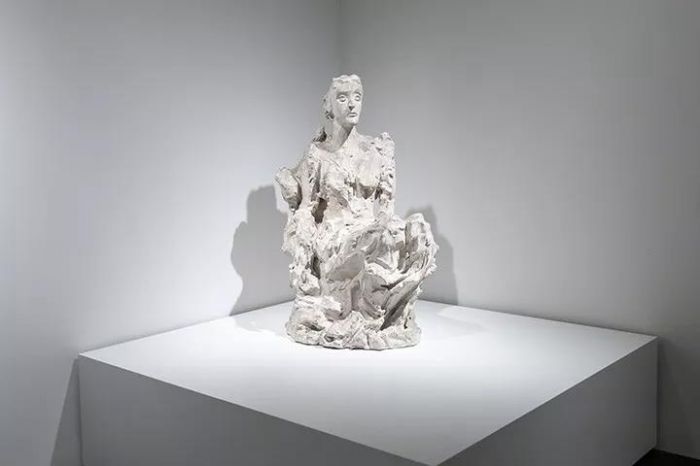
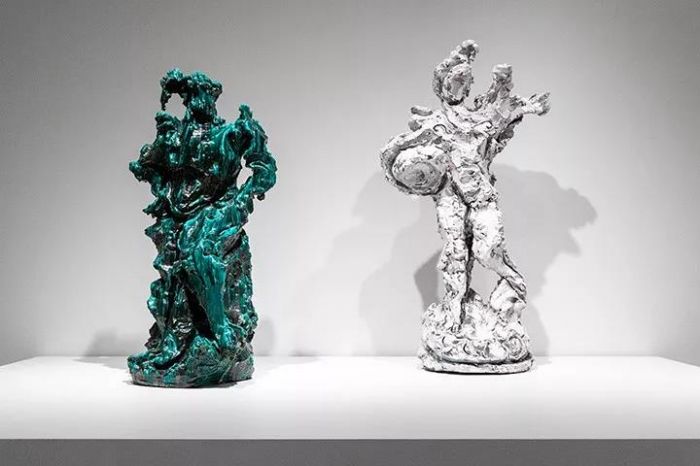

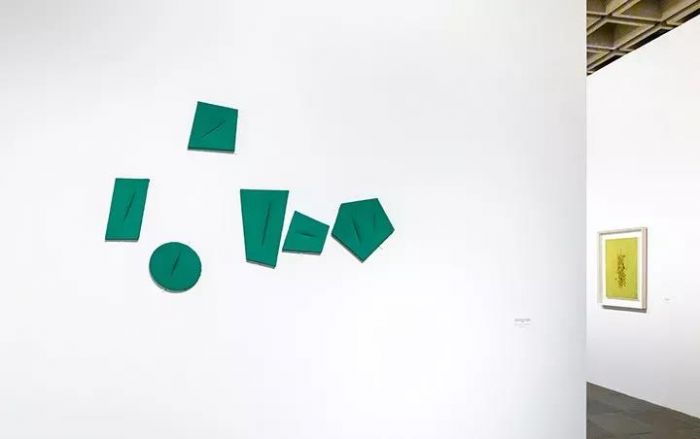
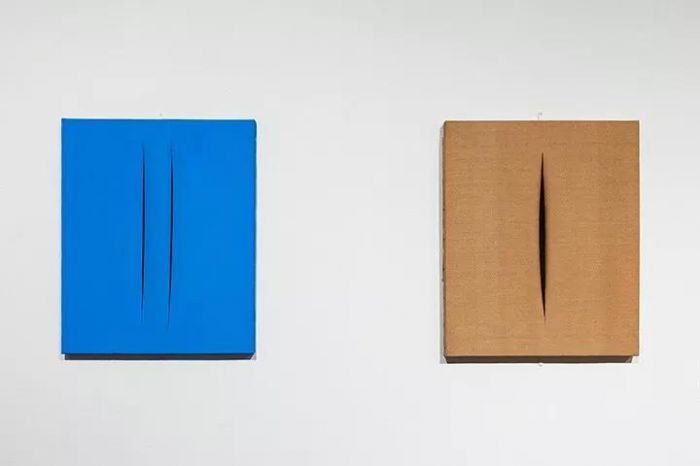
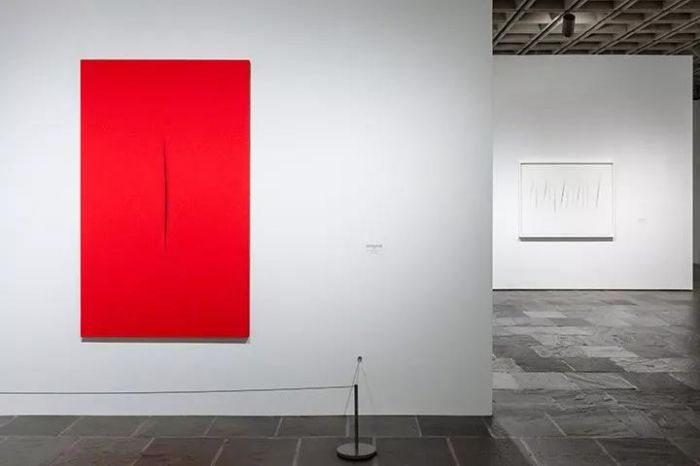

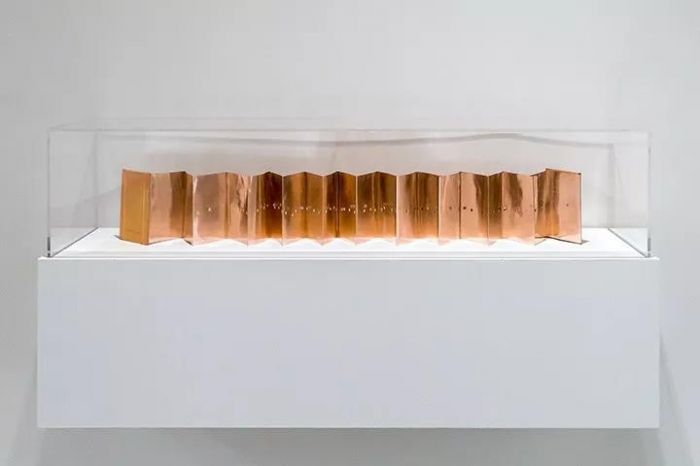

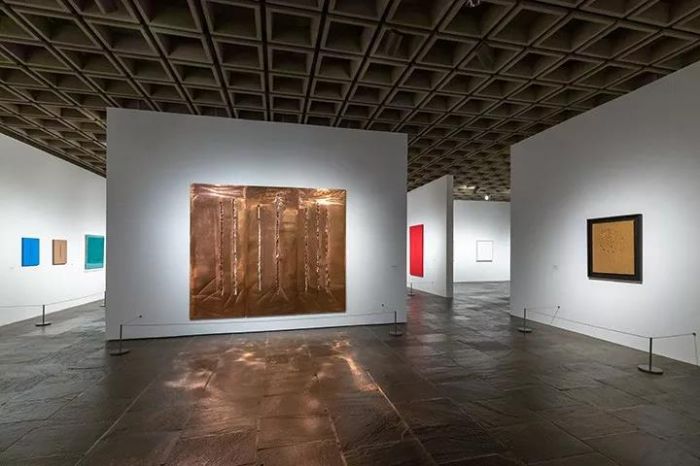
∧摄影:Corrado Serra。
封塔纳于1968年去世。展览的标题“新纪元”不仅指的是展览所强调的他早期的艺术生涯,也指的是他作为当代艺术鼻祖的地位。现今我们习以为常的东西——装置、新媒体和定义了许多21世纪艺术行业的多学科联动——封塔纳在20世纪50年代就率先提出。
他早期的职业生涯以丰富的实验为标志,无论是用粘土挑战意大利的雕塑规范,还是积极参与阿根廷的前卫艺术,20世纪30年代和40年代的早期作品都指向了20年后他作品的越界本质。1940年,他逃离欧洲的战争,回到阿根廷。在那里,他与豪尔赫·罗梅罗·布雷斯特(Jorge Romero Brest)和豪尔赫·拉科(Jorge Larco)一起,在布宜诺斯艾利斯创办了阿尔塔米拉艺术学校(Altamira art school),并与学生一起出版了1946年的《疯狂的布兰科》(Manifiesto Blanco)。这份文件展示了封塔纳空间主义的初步探索,他在1947年回到意大利后继续发展这一理论。他想创造一种符合时代的艺术,拥抱科学和技术,并揭示平面的一个新维度:画布之外的空间。
而后,封塔纳于1948年返回意大利。他带来了他长期以来发展起来的关于新艺术应该如何发展的思想,在空间主义这个术语下形成并付诸实践。虽然他一直认为自己是一个雕塑家,但在51岁时,他开始创作油画,抽象的,单色的,加以点状的图案。
最重要的是,这些点——他称之为“洞”(Buchi)——不是用刷子或笔画的;他们被刺穿了帆布。过去绘画只是描绘空气、空间和光线,现在它融入了真实的物理元素。
展览的作品包括:

∧.Left: Lucio Fontana, Spatial Concept, Expectations (Concetto Spaziale, Attese), 1959, Oil on canvas, 90.8 × 90.8 cm, Olnick Spanu Collection-New York
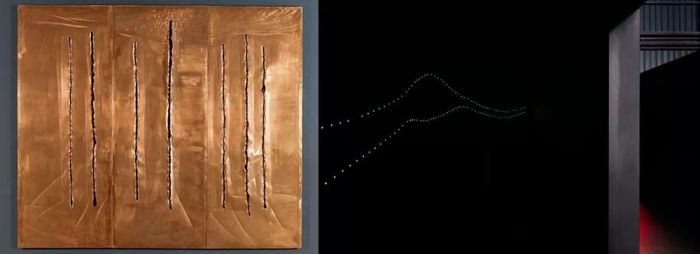
∧Left to right: Lucio Fontana, Spatial Concept (Concetto Spaziale), 1955, Oil and glass on canvas with holes, 81 × 65 cm, Private Collection / Lucio Fontana, Spatial Concept (Concetto Spaziale), 1950, Oil on canvas with holes, 85 × 65 cm, Fondazione Lucio Fontana-Milan / Lucio Fontana, Spatial Concept, Nature (Concetto Spaziale, Natura), 1959-60, Terracotta, 40 × 55 × 46 cm, 27.2 kg, Private Collection, Courtesy Neal Meltzer Fine Art-New York / Lucio Fontana, Spatial Concept, The Bread (Concetto Spaziale, Il Pane), 1950, Terracota, 42 × 33 × 3.5 cm, Fondazione Lucio Fontana-Milan

∧Left: Lucio Fontana, Spatial Concept, The End of God (Concetto Spaziale, La Fine di Dio), 1964, Oil on canvas, cuts, holes, 178 × 123 cm, Rachofsky Collection-Dallas. Center: Lucio Fontana, Spatial Environment (Ambiente Spaziale), 1968, Documenta 4-Kassel. Right: Lucio Fontana, Spatial Concept, The Quanta (Concetto Spaziale, I Quanta), 1959, Water-based paint on canvas with slashes, 6 parts, dimensions variable, Private Collection-Italy
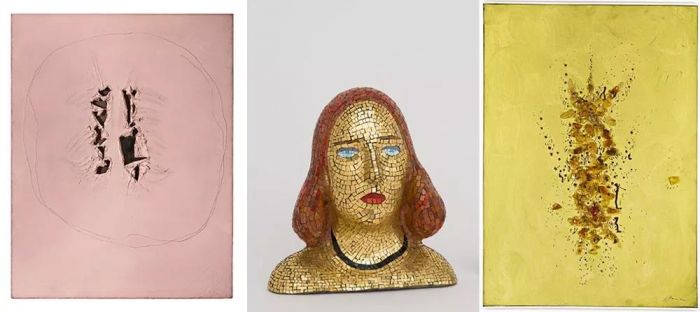
∧3.Left: Lucio Fontana, Spatial Concept, The End of God (Concetto Spaziale, La Fine di Dio), 1964, Oil on canvas, cuts, holes, 178 × 123 cm, Rachofsky Collection-Dallas. Center: Lucio Fontana, Spatial Environment (Ambiente Spaziale), 1968, Documenta 4-Kassel. Right: Lucio Fontana, Spatial Concept, The Quanta (Concetto Spaziale, I Quanta), 1959, Water-based paint on canvas with slashes, 6 parts, dimensions variable, Private Collection-Italy
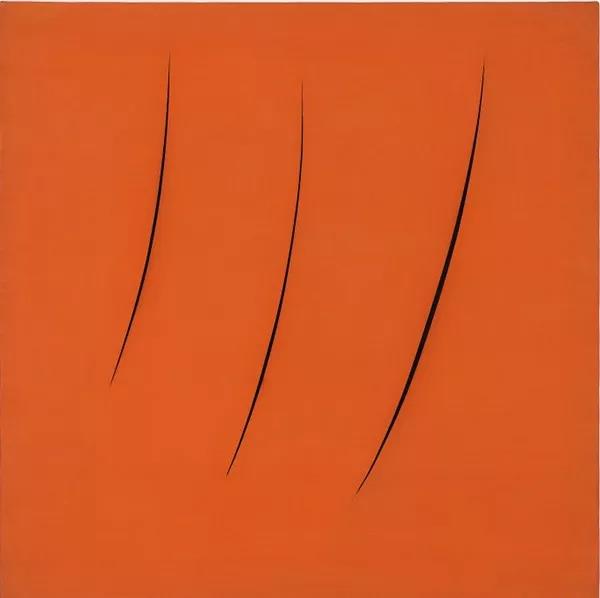
∧.Left: Lucio Fontana, Spatial Concept, Expectations (Concetto Spaziale, Attese), 1959, Oil on canvas, 90.8 × 90.8 cm, Olnick Spanu Collection-New York

∧Left to right: Lucio Fontana, Spatial Concept (Concetto Spaziale), 1955, Oil and glass on canvas with holes, 81 × 65 cm, Private Collection / Lucio Fontana, Spatial Concept (Concetto Spaziale), 1950, Oil on canvas with holes, 85 × 65 cm, Fondazione Lucio Fontana-Milan / Lucio Fontana, Spatial Concept, Nature (Concetto Spaziale, Natura), 1959-60, Terracotta, 40 × 55 × 46 cm, 27.2 kg, Private Collection, Courtesy Neal Meltzer Fine Art-New York / Lucio Fontana, Spatial Concept, The Bread (Concetto Spaziale, Il Pane), 1950, Terracota, 42 × 33 × 3.5 cm, Fondazione Lucio Fontana-Milan
在20世纪60年代初,封塔纳完全接受了单色,在他的作品中寻找纯粹和规律性,以克服非艺术的某些混乱。通过空间主义,封塔纳追求艺术的综合,他的多学科方法扩展了艺术体验的概念,进而拥抱周围的空间。他称之为“氛围”。他对光和空间的实验,包括他对霓虹灯的使用,为环境和装置艺术令人兴奋的未来发展奠定了基础。
展览的作品还包括:

∧“Spatial Concept, The Moon in Venice,” 1961. By attaching chunks of colored, light-catching Murano glass to the canvas, Fontana turned paintings into reliefs. CreditFondazione Lucio Fontana/Artists Rights Society (ARS), New York/SIAE, Rome; Vincent Tullo for The New York Times
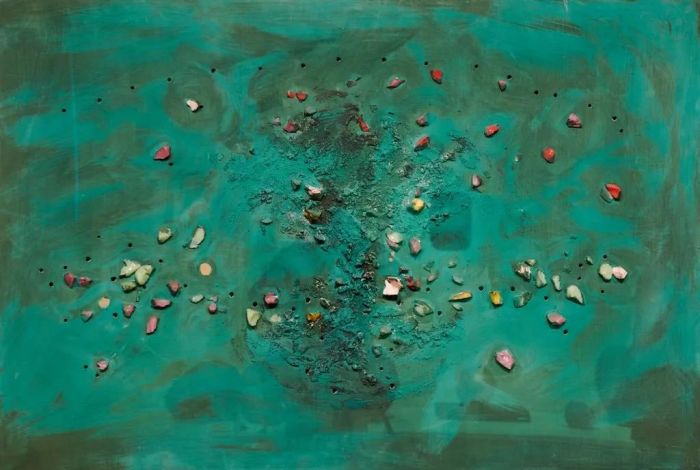
∧Fontana created sculpture-painting hybrids like “Spatial Concept,” 1955, oil and glass on canvas with holes.CreditFondazione Lucio Fontana/Artists Rights Society (ARS), New York/SIAE, Rome; Vincent Tullo for The New York Times
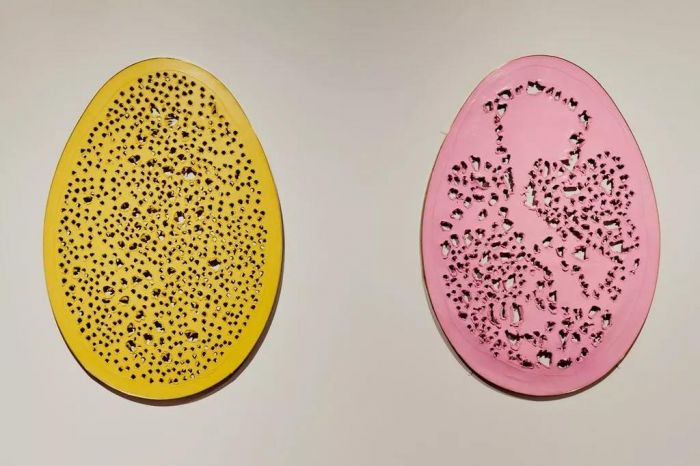
∧Paintings in sculptural form resemble giant Easter eggs blasted by shotguns. Left, “Spatial Concept, The End of God,” 1964. Right, “ Spatial Concept, The End of God,” 1963.CreditFondazione Lucio Fontana/Artists Rights Society (ARS), New York/SIAE, Rome; Vincent Tullo for The New York Times

∧Detail from “Spatial Concept, New York 10,” 1962, copper with cuts and scratches.CreditFondazione Lucio Fontana/Artists Rights Society (ARS), New York/SIAE, Rome; Vincent Tullo for The New York Times
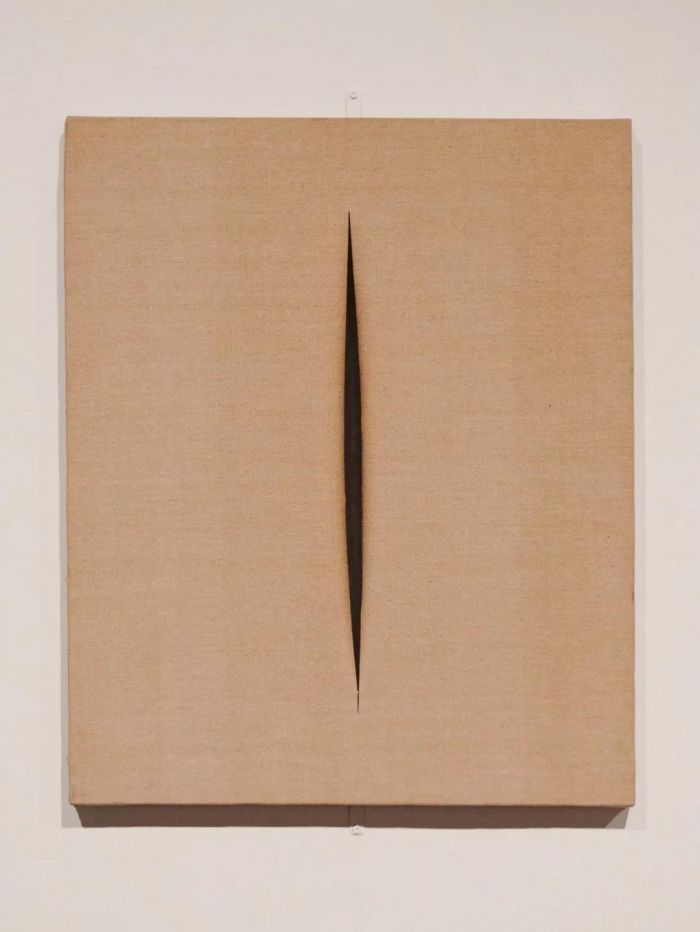
∧“Spatial Concept, Expectation,” 1968, canvas with slash.CreditFondazione Lucio Fontana/Artists Rights Society (ARS), New York/SIAE, Rome; Vincent Tullo for The New York Times
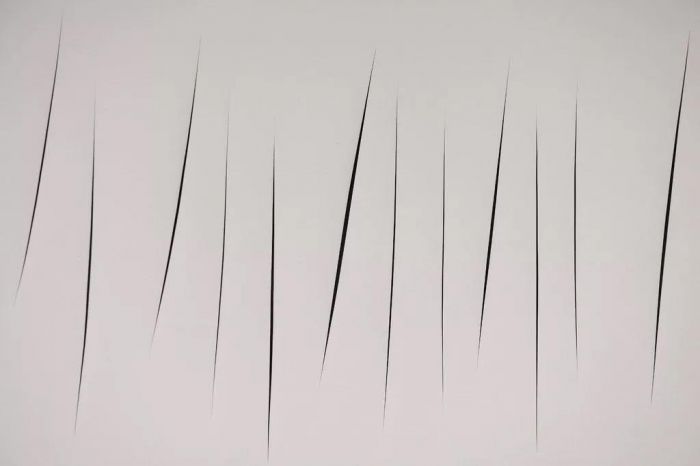
∧“Spatial Concept, Expectations,” 1965, water-based paint on canvas with slashes, originally with wood frame.
CreditFondazione Lucio Fontana/Artists Rights Society (ARS), New York/SIAE, Rome; Vincent Tullo for The New York Times
“我的艺术从来不是争论性的,而是当代的。”他说。
在他的职业生涯晚期,作为一位纪念碑制造者,他将自己的创新永久地以金属雕塑的形式加以纪念。展览中有两件铜制品,它们像画一样挂在墙上,像陵墓的门一样又大又重。它们的表面是一堆坑坑洼洼、以及伤疤,但它们反射了画廊周围的光线,光线漫过墙壁,洒在黑色的石头地板上。
就像封塔纳所做的很多事情一样,当你凝视眼前时,他已经在很远的地方了。
展览已于至4月14日在纽约结束,现在正在毕尔巴鄂古根海姆博物馆举行,时间为5月17日至2019年9月29日。
(图片来源于目刻时光)
